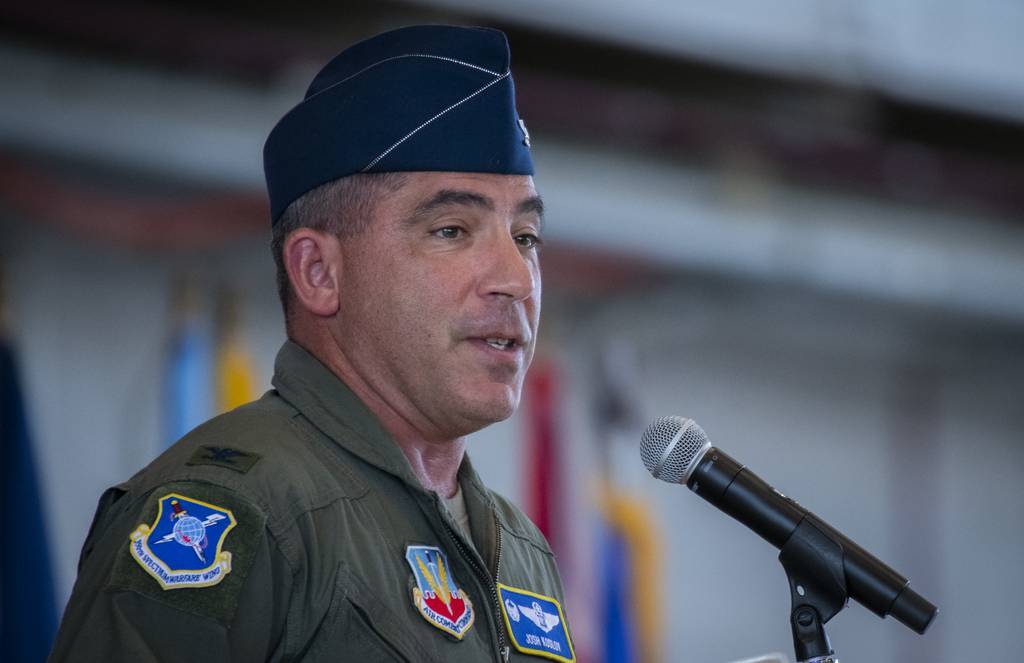
The Air Force is “very close” to being able to rapidly update electronic warfare systems with fresh battlefield data in a matter of hours, one of the service’s commanders said Wednesday.
Col. Josh Koslov, commander of the 350th Spectrum Warfare Wing, has set an ambitious goal of updating EW systems within three hours, instead of days.
In a webcast hosted by C4ISRNET, Koslov said that three-hour goal — which he once referred to as a “moonshot” — is now within reach.
“We’re very close to that, if not exceeding, in most of the systems that we cover in the spectrum warfare wing,” Koslov said. He went on to say that more than half of the 70 EW systems his organization touches across the Air Force are either at or below the three-hour mark for updating.
But many of those systems have unique elements, he said, and the Air Force’s EW systems need to make more use of interoperability and open architecture standards to simplify the process for rapid data updates.
And Koslov said his wing will need enough resources to develop these data production methods that will allow the military to process this data on a large enough scale to work in war, and then transport the data back to the field.
Koslov and Brig. Gen. Ed Barker, the Army’s program executive officer for intelligence, electronic warfare and sensors, said in the webcast that in a future war against an advanced adversary, conditions on the battlefield, threats and targets will likely change so quickly that rapid updates to EW systems will be critical.
‘Data is the weapon’
“We have to be able to continue to add pressure to the adversary in a war in order to seize the advantage and achieve our objectives,” Koslov said. “Data is the weapon that will allow this to happen, and data processing is the way to do that.”
This will include combining data from all sources in the joint force, such as Army units on land, naval ships in the Pacific, or airborne platforms, he said, and then combing through that information to find new threats. The military must then use that data to develop a way to counter that new threat, and then get that new capability back to the field.
To achieve these kind of rapid data updates, Koslov said, the Air Force has revamped its tactics, techniques and procedures to have more of a “warfighting” focus.
When asked whether data updates could be made to systems remotely, or whether they would require something to be physically plugged in, Koslov said that would depend on the EW system. He said information would be transported to Eglin Air Force Base in Florida, where the 350th is located, or other reprogramming centers where more people can process the data.
That will be especially useful during a major conflict against a nation such as China or North Korea, he said, in which joint forces would be spread out across the Pacific region.
“When you come out with a new capability, it’s not good if you just get it into one pocket,” Koslov said. “You have to be able to get it across the force. And so centralizing that is going to be the right way to do that as we move forward.”
The Air Force activated the 350th in 2021, and has since been building up its capabilities by adding more units. Earlier this year, the wing stood up two new electronic warfare squadrons — the 388th at Eglin and the 563rd at Joint Base San Antonio-Lackland in Texas.
The 563rd is focused on building new EW software for operational units to respond to the threats they encounter in the field. And the 388th is focused on studying adversaries such as China to find ways to breach and thwart their digital capabilities.
Koslov said his wing is next focused on building out the 950th Spectrum Warfare Group at Robins, which is expected to be fully activated in 2027. The 950th will be in charge of assessing the EW systems in Air Force’s combat aircraft and improving EW capabilities.
“Everything has to be assessed from a platform perspective — does the platform do what we’ve asked it to do?” Koslov said. “But also our [tactics, techniques and procedures] have to be assessed. … How good are we at fighting and training in the [EW] spectrum?”
Author: Stephen Losey
Source: DefenseNews



